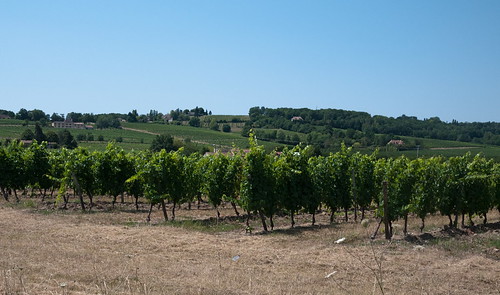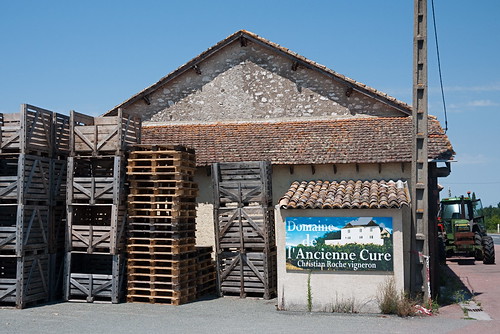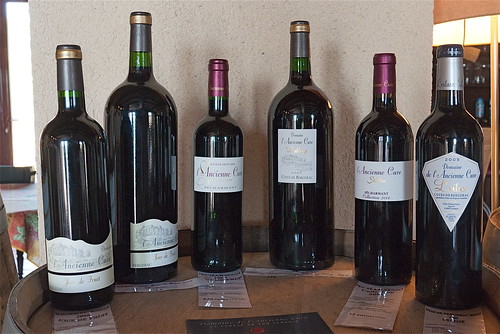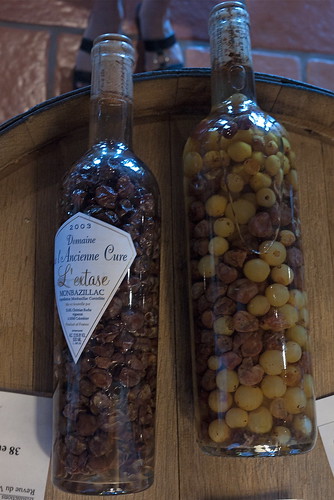The Bergerac wine region lies along the Dordogne river and is the biggest appellation in the south west of France, producing red, dry white, and sweet white wines. The grapes growing in the region are similar to the Bordeaux varieties but the local climate is more continental and less influenced by the Atlantic ocean. Winters are mild and summers are long and can be very hot with occasional storms and showers.

Vineyards in the Bergerac Appellation
During the week that I spent in the area, I had the opportunity to visit the Domaine de L'Ancienne Cure. It is a family owned estate growing grapes in the Bergerac, Pécharmant, and Monbazillac appellations. The name of the domain refers to the old presbytery that Hélène and Gaston Roche bought in 1946 in the small village of Colombier, several kilometers from the town of Bergerac. They were mainly growers at the time, sending most of their grapes to the local cooperative. In 1984, their son Christian Roche inherited part of the family property and built its own winery to become an independent winemaker. Since 2009, the estate has been converting to organic viticulture.

Domaine de L'Ancienne Cure
At the domaine, we were warmly welcomed by a friendly and knowledgeable staff. We sat at the large farmhouse table in the middle of the tasting room and spent two hours tasting and talking about the estate production. The winery makes dry white, sweet white and red wines in three different lines: Jour de Fruit for fruit-forward, ready-to-drink wines, L'Abbaye for more concentrated, age-worthy wines, and the top of the line, L'Extase.
We tasted the following wines:
• 2009 Bergerac Sec Domaine de L'Ancienne Cure L'Abbaye: 30% Sauvignon Blanc, 20% Muscadelle, 25% Sémillon, and 25% Sauvignon Gris. Sauvignon Gris is a rare grape variety on the brink of extinction that has been revived recently in Bordeaux and in the south west. Manual harvest, aged 9 months in barrel, 30% new. My notes: deep golden color, sweet floral nose. On the palate much drier than it smells, peach, tropical fruit aromas, creamy mouthfeel.
• 2008 Bergerac Sec Domaine de L'Ancienne Cure L'Extase: 45% Sauvignon blanc, 35 % Sémillon, 20 % Muscadelle. Manual harvest, 60% new oak barrels. My notes: deep golden color, intense nose, lots of freshness on the palate with additional citrus notes, great balance between acidity and richness.

The red wines
• 2008 Pécharmant Domaine de L'Ancienne Cure Collection: Pécharmant is a small appellation on the north bank of Bergerac. The name means charming hill, pech coming from the occitan word puèg which means hill and charmant meaning charming. The wine is a blend of 50% Merlot, 25% Cabernet Sauvignon, 25% Cabernet Franc. Aged 18 months in new oak barrels. My notes: dark color, blackberry nose, very young, still tight and not really "made" yet (with the fruit on one side and the oak on the other side), age-worthy.
• 2005 Bergerac Domaine de L'Ancienne Cure L'Extase: 50% Merlot, 40% Cabernet Sauvignon, 10% Cabernet Franc. Grapes are harvested very ripe on calcareous soils and with more acidity on clay soils. Aged 19 months in new oak barrels. My notes: deep color, gamey aromas, ripe blackberries, jammy, quite silky on the palate, fine tannins, good acidity, age-worthy.

The sweet Monbazillac wines
• 2009 Monbazillac Domaine de L'Ancienne Cure Jour de Fruit: the wines of Monbazillac were already well-known in France in the 14th century but were discovered by the Dutch in the 17th century during the Wars of Religion when many Protestants from the Bergerac area emigrated to Holland. Like nearby Sauternes, the wine is issued from Sémillon, Sauvignon Blanc, and Muscadelle grapes harvested by hand when the grapes are affected by the noble rot or botrytis cinerea. The wine is a blend of 90% Sémillon, 10% Muscadelle. My notes: light golden color, floral nose. On the palate, light-bodied, sweet and fresh without been sirupy, nice citrus on the finish, good acidity, great with foie gras.
• 2003 Monbazillac Domaine de L'Ancienne Cure L'Extase: 90% Sémillon, 10% Muscadelle. Careful selection of the best berries, aged in new oak barrels. My notes: deep amber color, powerful nose of madarin orange. On the palate, very rich, sweet, long finish.

Showing the different amounts of botrytised fruit used in the Jour de Fruit and Extase cuvées
Technorati tags: wine food & drink
2 comments:
Nice post, thank you for sharing. You have really imparted useful knowledge. A very useful post I must say. Awesome content, I bookmarked it for future reference.
Thanks for this intelligent, detailed blog. We are distributors of these wines in Australia so of course I am bias but your blog conveyed the fact that these wines are so well made and delicious and good value. A little gem of a vignoble and a gem of a blog entry. Will be following your blog enthusiatically. Thank you.
Post a Comment